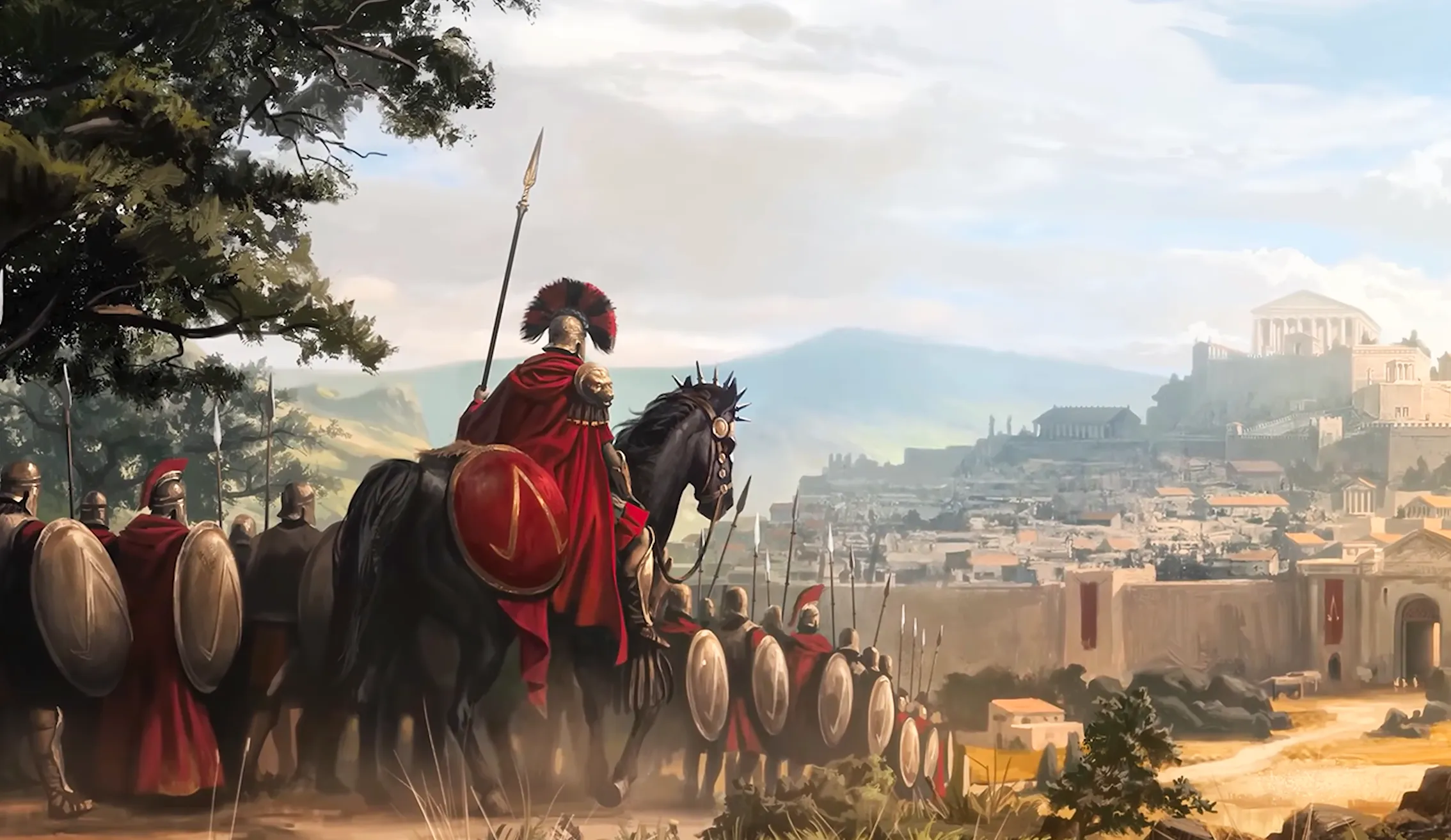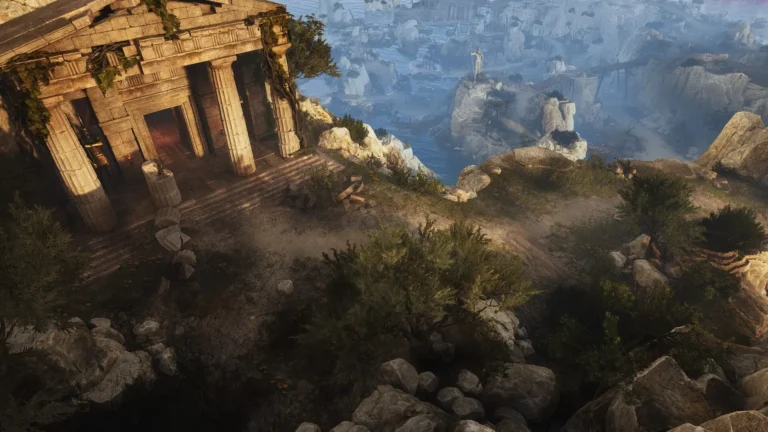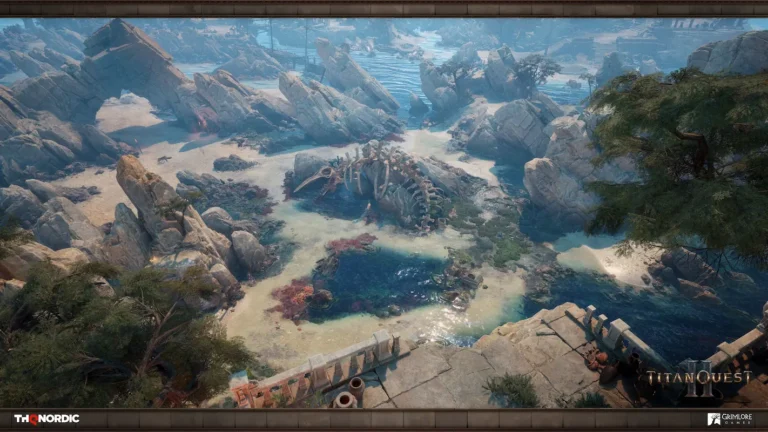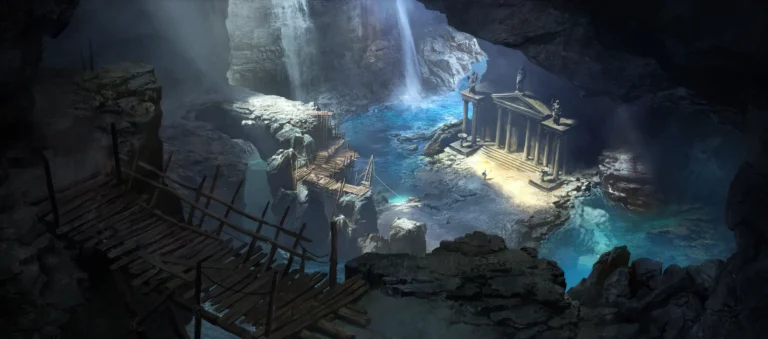In Titan Quest 2, players can combine two Masteries to make a unique class to play through the campaign with. While nearly everything in the game can be changed, your Mastery selection is the one thing that cannot, and it is permanent. With that in mind, this leveling short guide will focus on the Mastery combination of Warfare and Storm to create the Tempest class!
Keeping in mind that you can alter your build any way you wish for a small gold fee at any point in your playthrough, we are using these short guides as a way to provide players with a path of least resistance while leveling. For players used to more punishing ARPGs, you can rest easy with Titan Quest 2; the only decision that is permanent is Mastery selection. You will not be locked out of anything you wish to do later on, so there is zero downside to following a specific build early on.
Note: All builds have been tested at +5, even while leveling. You should not have any issues progressing the campaign while following the build on this page. If you’re at a gear deficit, lowering the enemy level may be in your best interest until you gain some upgrades.
Quick Navigation
Leveling Build: Lightning Bow Mage
To make this build function, Storm will be prioritized first to gain levels in Lightning Bolt as quickly as possible. Warfare will be mainly used to complement Lightning Bolt by adding Attack Speed, Spell Rage, and Rage effects. In the very beginning, however, we will level up with Ice Shards, but they will almost be immediately replaced once we have enough Divinity and a bow to use. This should happen very early in the campaign.
Once enough divinity is had, we fully commit to Lightning Bolt and then will spend our first set of passives into Warfare. If you must commit to a passive early, you can always respec to it later and follow the leveling chart below.
- Great Area Agro and Clear
- No complicated button mechanics.
- Persistant Area Damage
- Very Mobile
- Attacks must be aimed.
- Players must position correctly.
- No Primary Attack Scaled
- Not designed to face-tank.
Video Showcase
Please check back later once Early Access starts and we have a chance to record footage!
Stat Priority and Gear Options
Upon leveling, you will be allotted two Attribute Points to spend as you see fit. All gear has specific requirements, and certain attributes increase specific types of damage that your character can deal. For this build, we’ll focus as many points as possible on Knowledge and Agility, with Vigor as our secondary priority. By focusing on these three attributes, we maximize the contribution placed in Cunning, the main stat driver for Lightning damage. It is possible to be exclusive into Agility and Vigor, however, we found gearing to be very difficult without some blend of the three.
Armor, Glancing Hits, and i-Frames
Agility will be the heavy focus here, as this is the attribute that allows us to wield ranged weapons we look for, while Might and Fitness allow you to use heavier bows. We found that the greatest increases to attack speed come from Agility–based bows. Your Raw HP will not be high enough to face tank; this gear is to keep you safe in an engagement where you cannot manually dodge the damage yourself. Unlike Titan Quest 1, there is no passive dodge mechanic, and there is no flat Damage Absorption or Defensive Ability at this time. We only have Life, Barrier, Armor (Strike and Pierce Armor are separate types), Resistance, and Glancing to utilize as defensive layers.
Weapons
As far as weapons are concerned, you will want a bow. However, early on, you can utilize any weapon or staff, as Ice Shards can still be used fairly efficiently. Later, we will want to remove Ice Shards and have our Lightning Bolt skill converted to utilize our bow. Spears work for this setup as well, although we found Bow was the best offensive setup. A spear and a Shield can be used on your Weapon Swap for more difficult engagements.
Attack Speed, Critical Hit, and Added Lightning Damage are all very useful for this build. We won’t be focusing on ailment application, so try to avoid weapons with stats that cater to it. Flat Damage is king; however, at this point in time, the Damage Tooltip seems to be working effectively for this damage type. When deciding what bow is better, referencing that can be a good method to check.
Divinity Allocation
In Titan Quest II, as you level up, you’ll gain Divinity points, which are crucial for unlocking higher tiers in your chosen masteries. Like skill and passive points, Divinity points can be respecced, allowing you to flexibly adjust your build without permanent consequences. This guide details the optimal allocation of Divinity points to enhance your mastery tiers. Initially, prioritize investing your first 18 Divinity points into the Storm mastery, then into Warfare as you recieve them. Because our main skill is not exhaustive, we dont need to focus on getting any Core Skill points. Some may be added to our Dodge if the you run out of points to place.
Skills and Passives
Below, we will be listing the skills and passives you should be taking. Anything highlighted in the table should be sought after as soon as possible, as it’s crucial for the build to function as intended.
| Skill/Passive | Number of Points | Feats and Modifiers |
|---|---|---|
| Lightning Bolt (Storm Skill) | 17 | Weapon Attack 1/1 Rage Gain 3/3 Additional Projectiles 2/3 Lightning Strikes 2/3 Gain Flow 1/1 (Skipped until Barrage is unlocked) |
| Weapon Proficiency (Warfare Passive) | 12 | Attack Speed Critical Chance |
| Storm Nimbus (Storm Skill) | 17 | Lightning Imbuement 1/1 Storm Enchantment 5/5 Thunderstorm 3/3 |
| Battle Rage (Warfare Passive) | 8 | Rage Amount Rage on Kill |
| Invoker of War (Warfare Passive) | 4 | Spell Critical Hit Chance |
| Storm Attunement (Storm Passive) | 12 | Weapon Damage Projectile Damage |
| Blink (Storm Skill) | 7 | Thunderstorm 3/3 Repeat 1/2 |
| Lightning Evoker (Storm Passive) | 8 | Damage Rage |
| Raging Storm (Storm Passive) | 8 | Rage Amount Rage Overflow |
| Barrage (Warfare Skill) | 17 | Extended Barrage 1/1 Enhanced Precision 3/3 Projectile Penetration 1/3 Ramp Up 3/3 Consume Flow 2/5 (Be sure to add flow from Lightning Bolt) |
| Raging Mind (Storm Passive) | 6 | Critical Chance |
The above allotment can take you to around Level 26+, but feel free to experiment with extra Divinity, as you should have plenty. Please check back at a later time when we get more content. If there’s a need to extend the leveling build, we will do so here!
Rotation and Build Mechanics
This build is a “Bow Mage” setup, and doing so means we must act like a mage and stay away from the danger by positioning ourselves correctly. It focuses heavily on positioning in and out of combat with Blink. Energy management should not need much help, as we can unleash our Lightning Bolt freely without much strain on our resources. Passively, our Lightning Strikes will hit enemies or objects across the battlefield. Be wary of this, as we pull enemies from all different directions since we cannot control where the lightning strikes.
Utilize our Blink to get into or out of combat, as it can be cast a third time to return to our original position. Do not make the mistake of porting back into a DoT (speaking from experience). Freely use your Barrage at more difficult mobs, but be aware that it won’t do as much damage without a charge of Flow to consume. Boss engagements are a rotation through Lightning Bolt until we have Flow, then use Barrage. Blink can and will clean up trash that remains.
Our primary Aura, Storm Nimbus, will do a few things for us. This aura will:
- Convert our base weapons damage to Lightning.
- Increases our Lightning Strike (passive damage) by 60%.
- Allows Lightning Strikes to attack without any interaction passively.
We heavily rely on our attack speed with Lightning Bolt, as 20% of the time, we will trigger a Lightning Strike. This works in cohesion with our Lightning Evoker passive. Which means every time we attack with this passive, we have a 45% chance to hit a random enemy with Lightning Strike. This only grows more frequent as we ramp up our Rage.
Defensive Scaling
This build focuses on three main things when it comes to survival.
- Manual Dodging of Damage Mechanics (Intagibility Duration or i-Frames)
- Resistances
- Armor (and killing things long before they get to us)
Armor Rating is done almost entirely through our gearing selection, mentioned higher up on this page. Barrier can be used and is very helpful, but it will not be scaled, so do not rely on it to save you from massive damage situations. We rely on our health flask for regen, or whatever we can find on our gear; however, we shouldn’t be taking that much damage because of our playstyle.
Resistances are very helpful, but they only cap at 60%. So understand you will not be immune to any damage source.
Keeping all of this in mind, it is important to play this as the role of a Mage. You are looking to distance yourself when appropriate and to out-maneuver your enemies. Position them to be decimated by your linear area attack that triggers further attacks at random. Large groups are best picked off from afar, or if the area allows it, when you have a height advantage. Feel free to use your Lightning Bolt to farm pots and crates, as it’s mainly free to use.
Leveling Tips
Check out our list of tips specifically for this build, and it may not apply to other builds.
- Energy consumption is something you must control at all times! Move your skill nodes around to ensure this is not a problem. The worst thing that can happen is running out of Energy in the middle of combat. Some gear experimentation is necessary to learn this. Be aware that almost every node adds to the cost of a skill’s energy.
- It is possible to reserve too much Energy. If this happens, there are a few nodes that reduce the Energy Reservation rather than increase it. Sacrifice a bit of damage to ensure you’re not draining your resources too much.
- Barrier, regardless of scaling, is your best friend. Get in the habit of tapping this right as you encounter enemies. It will ensure you stay healthy and avoid needing to use a health pod.
- Movement is key, and movement speed should be considered another kind of defensive scaler for a rogue.
- Some skills or passives can be played with as long as you keep the synergy of the build. We are looking for Critical Chance, Rage, and Attack Speed.
Some helpful notes for all players, regardless of their build or class, are listed below.
- Check Merchants for gear as often as possible. Merchants refresh stock on level up.
- Make sure you’re bumping the level range of areas when you can do so comfortably for better experience and drop rates.
- Utilize the DPS estimation on tooltips. It may not be obvious that a new weapon is an upgrade.
- Watch your Resistances. While these don’t need to be capped (60%) while leveling, it doesn’t hurt to try to keep them balanced.
- Keep in mind that several mechanical intricacies from Titan Quest 1 have changed, and some things will have to be relearned.
- As in most ARPGs, you can find gear specifically that is great for leveling. Be sure to stash these, as they can be used across your other characters.



